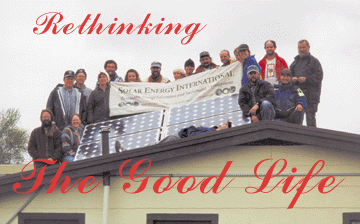
Above: Redwood
Alliance’s
Take Your Bedroom Off the Grid workshop crew ’99.
This year—grid intertie.
Author Christine Parrais on the lower
right. |
Rethinking the Good Life
As Published
in Home
Power Magazine
©1999 Christine Parra |
Go below to Sidebar for this article.
 t had been a long, dark New York winter. Each morning, sleepy
commuters, Wall Street Journals in hand, roused themselves from their morning
naps as the train pulled into Grand Central Station. And each night, the
Metro-North commuter train between New York and Connecticut made its trip back.
I was one in an army of trench-coated, newspaper-carrying businesspeople. The
spring day had been much like any other except that, in place of a newspaper, I
held an issue of Home Power in my hand.
t had been a long, dark New York winter. Each morning, sleepy
commuters, Wall Street Journals in hand, roused themselves from their morning
naps as the train pulled into Grand Central Station. And each night, the
Metro-North commuter train between New York and Connecticut made its trip back.
I was one in an army of trench-coated, newspaper-carrying businesspeople. The
spring day had been much like any other except that, in place of a newspaper, I
held an issue of Home Power in my hand.
Below: Johnny Weiss, Solar Missionary,
is a master of
RE education and instructor of many of SEI’s
workshops. Experience him if you can.
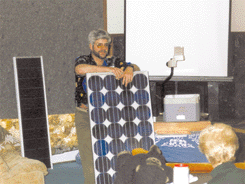 I had picked up a copy during a Solar
Energy International workshop in Colorado the previous summer, and have
subscribed ever since. I was tired of the Journal, which was so ubiquitous on
the trains and in offices. I realized that there was more to life than constant
earning and unbridled consumption, but couldn't identify it.
I had picked up a copy during a Solar
Energy International workshop in Colorado the previous summer, and have
subscribed ever since. I was tired of the Journal, which was so ubiquitous on
the trains and in offices. I realized that there was more to life than constant
earning and unbridled consumption, but couldn't identify it.
The Good Life?
I had made a model life: the executive house
in the suburbs on 2.5 acres of land, sport utility vehicle, car, etc. There
was, however, little connection with the seasons, no letup in the pressure to
pay the huge monthly mortgage, little time for peace and reflection,
extracurricular activities, or relationships. The illusion of wealth was
accompanied by a severely impoverished quality of life.
But in this issue of Home Power (HP22, p. 26), I read
about a group of people at Humboldt State University (HSU) who were making
hydrogen from the sun and using it in a fuel cell. Something in the article
struck me: these people were developing a technology that would make a clean,
domestic hydrogen economy possible. I was inspired to move to California and
study engineering.
I became a graduate student in Environmental Resources Engineering (ERE)
at Humboldt State University in the fall of 1992. By the spring semester, I had
enough background to complete basic tasks at the Schatz solar hydrogen facility
as a volunteer. By the end of the 1993 spring semester, I was working as a paid
employee at the Schatz lab, which I continued to do throughout my student
years. After two more years of statistics, engineering, and design courses, as
well as calculus, physics, and chemistry prerequisites, I wrote a thesis and
graduated with a Master's Degree in ERE.
Hydrogen Research
Peter Lehman and his colleague Charles
Chamberlin direct the Schatz Energy Research Center, which is funded by a
generous grant from Dr. L. W. Schatz, a retired businessman and self-made
millionaire. The center has produced the only solar hydrogen fuel cell facility
in the world, as well as America's first fuel cell powered car. The center's
staff consists of a talented bunch of fifteen like-minded engineers and
scientists, mostly graduates of the HSU Engineering program.
Those of us who work at the Schatz Energy Research Center acquired
design, fabrication, and operating experience in solar electrolysis, fuel
cells, integrated power systems, and programming. My own activities have
included photovoltaic (PV) and fuel cell system design, marketing and economic
analysis, budgeting, teaching, and even hands-on involvement with the hardware.
Our projects have ranged in size from small, local initiatives to multimillion
dollar, government-funded programs.
Below: Jay Peltz of Alternative
Energy
Engineering helps students get their
hands on renewable energy
equipment.
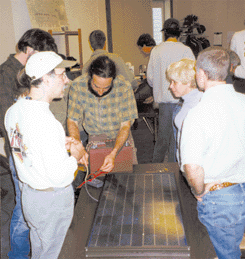 Take Your Bedroom off the Grid
Take Your Bedroom off the Grid
In my eagerness to become more familiar with the hardware for small PV systems,
this past May I attended a Take Your Bedroom off the Grid workshop. This
weekend workshop was hosted by Redwood Alliance and taught by Johnny Weiss of
Solar Energy International. Sharice Low and Chane Binderup of Redwood Alliance
did an excellent job of organizing the workshop. Bob-O Schultze of Electron
Connection and Joe Schwartz from Home Power rode herd on the installation
portion and shared their expertise.
The main goal of the workshop was to show people how to take advantage
of the modularity of PV systems. You can start slowly and gradually increase
the size of the system as more cash becomes available. This article contains
ideas from the course that might help you with your PV system design. These
ideas might also help you design some other parts of your life.
Below: Demystifying RE installation
is one main workshop objective.
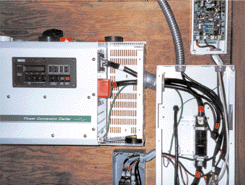 Independence & Conservation
Independence & Conservation
Renewable energy systems are dependable, quiet, and clean. They make
independence possible, and encourage conservation by making you aware of your
use of resources. With RE systems, you have a limited amount of energy
available for consumption. You have no choice but to be in touch with natural
cycles. You can't have a small PV system and be careless or inattentive. You
have to be thoughtful about your activities.
Are we ready to apply these ideas to other parts of our lives too? To
figure out the difference between true needs and desires? To understand the
difference between standard of living and quality of life? To stop chasing
material goods to achieve happiness? To apply technology thoughtfully? To look
at how we produce (in largely mechanistic, repetitive, specialized jobs) and
consume (often in programmed and isolating ways with destructive results)? Are
we ready to change? To earn less, use less, and have a greater connection with
the natural world? Maybe you can decide for yourself, based on the following
points covered in the course.
Know Your Resource and Determine Your Load
You really haven't
started a PV design until you've found out how much solar energy is available
to you and how much energy you need for your lifestyle. This is called
determination of resource and load profile.
The resource is pretty much set. The larger question is how you decide
to use what is available and how much you want to pay for certain conveniences.
Remember, it's costing us all the time we work during our lives to earn the
money we need for our lifestyles. It pays to consider resource versus load.
Below: TYBOG Schematic.
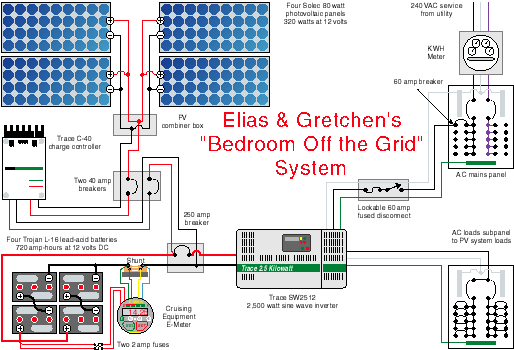 Don't Make More, Use Less
Don't Make More, Use Less
It turns out that
using less is easier than making more. As you're designing your renewable
energy system, you'll find that you pay quite dearly for small conveniences.
This doesn't mean that you shouldn't make your system large enough to make you
and your family comfortable. But it pays to think twice about each habit.
Have you ever calculated how much money it takes to satisfy your minimum
needs? Or calculated the actual cost of certain habits (let's be fair - dollar
cost to you as well as impact on the planet)? Have you tried measuring that
cost in hours at work or in stress?
Here's a secret that I've discovered since exiting the rat race: if I
consume less, then I need to buy less and I need to earn less money to buy it.
In addition, I have a smaller impact on the world. Or, taken one step further,
if I consume just enough to satisfy my spiritual and physical needs (as opposed
to my media-fabricated desires), then I spend less time earning and more time
hiking, dancing, and playing music.
This is the difference between "quality of life" and "standard of
living." Which makes me happier: to be doing things each day that I enjoy and
learn from, or to have as many material goods as I can accumulate in a
lifetime?
Remember also that the goal of maximum convenience can cause amazing
amounts of inefficiency and some questionable system design. Think about
convenience first and you wind up dragging oil from the Persian Gulf in order
to drive your car six miles down the road to the school or store.
Below: The fun part–puttin’
panels on the roof.
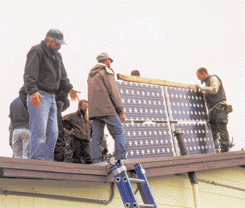 Our Resources Are Not
Infinite
Our Resources Are Not
Infinite
With a renewable system, you buy a bucket of energy. You no
longer behave as if you were connected to an infinite grid. If I behave as
though all resources were limitless, my behavior is not sustainable. Well -
face it - we're not connected to an infinite supply of anything. But this is
not actually bad news. A change in consciousness can lead to enjoying living
with less.
Do you remember from childhood what life was like when time was
infinite? A change in consciousness could produce uncluttered minds and houses,
more freedom, independence, and time. Such a shift is akin to the form of
medicine that uses pleasure to cure addictions - life feels so good that after
a while you forget about what you had to give up.
Not Every Technofix Is Useful
Just because you can do it
doesn't mean it's a good idea. Elegance and simplicity are often more valuable
than incorporating a lot of expensive, highly developed technofixes in your
system - and in your life.
Consider this: my partner and I recently went to buy a refrigerator for
our new house. The store offered a dizzying variety of options: 18 to 30 cubic
feet (0.5Ð0.8 m3); with an external or internal icemaker or without any
icemaker; with the freezer on the bottom, side, or top; highly efficient or not
efficient at all; and black, white, or stainless steel.
What is it that made me wish for the largest, top-of-the-line model? Did
I think to ask, "What are my exact requirements and how much of a refrigerator
do I truly need?" It's easy for me to say that California's gasoline prices are
too high. But rarely do I take offense at a salesperson's suggestion that I
"deserve only the best," even though it'll cost me (and the environment)
dearly. What if "the best" is not the biggest, most expensive, or most
advanced, but just what fills my specific need?
| System Costs |
|
| Item |
Cost
(US$) |
| Trace SW2512 inverter |
$2,445.00
|
| Four Solec modules, 80 watt |
$1,796.00
|
| Four Trojan L-16 batteries |
$792.00
|
| Two Seas universal rack, 6
module |
$460.00
|
| Trace DC250 breaker |
$275.00
|
| E-Meter with shunt |
$198.00
|
| Trace C40 charge controller |
$145.00
|
| Misc. hardware and conduit |
$115.68
|
| A.E.E. SWCB conduit box |
$85.00
|
| Two #4/0 inverter-battery cables, 8
foot |
$74.00
|
| #6 wire, 230 feet |
$64.40
|
| AC subpanel |
$53.15
|
| #2 wire, 67 feet |
$36.85
|
| Four #2/0 battery interconnect
cables |
$32.00
|
| Combiner block for PV |
$22.25
|
| Grid disconnect with box |
$20.42
|
| 6 by 6 by 4 inch rain-tight box |
$20.00
|
| 2-circuit breaker box |
$17.50
|
| E-Meter wire, 20 feet |
$15.40
|
| Two 50 amp DC breakers |
$13.90
|
| Shipping for rack |
$12.00
|
| Twelve Carflex fittings |
$11.88
|
| 60 amp AC breaker |
$11.25
|
| 6 by 6 by 4 inch elect. box |
$8.20
|
| Labor donated |
$0.00
|
| Total |
$6,724.88
|
| Sales tax |
$487.55
|
| Grand Total |
$7,212.43
|
There's No Substitute for Common Sense
If you're about to put
in a PV system, know your site. Go there, live there if you can, get to know
when and where the sun rises on the property at different times of the year and
understand when you'll need the most power. Keep in mind that no two renewable
energy systems will be completely alike, because all sites are different, and
all load profiles are different. There's no easy answer, and only your
thoughtfulness can give you the system that's right for you.
In our own lives, there's nobody to tell us when we're wasting our
hard-won resources of time and money. The average American spends about fifteen
hours a week in front of the TV, and makes numerous purchases that may only
meet the criterion of immediate gratification.
Below: Elias and Gretchen are proud
parents of a grid-intertied
photovoltaic system which produces clean
energy.
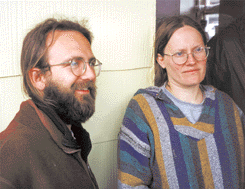 We're In This Together
We're In This Together
PVs come from
corporations. Pick your favorite polluting, government-subsidized, fossil fuel
company. And I hope that these corporations make money at their PV production.
Because that's how change will happen - when we make it profitable to do the
things that have a smaller impact on the environment.
No matter what ideals we hold, most people need and wish for similar
things in life: satisfaction of human needs for food, clothing, and shelter; a
sense of belonging, love, personal growth, and play; and connection with the
natural world. When we work together and lead thoughtfully examined lives, we
can meet our own needs without jeopardizing the ability of others (present and
future) to meet their own needs.
Newton said that "a system will remain in equilibrium until a net force
acts upon it." Renewable energy can be the net force that acts upon our
collective consciousness in favor of change. Living with renewable energy is a
great way to make us aware of everything else that we consume. It renews our
respect for each other and our reverence for our planet.
Access
Author: Christine Parra, Schatz Energy Research
Center, Humboldt State University, Arcata, CA 95521 · 707-826-4345
· Fax: 707-826-4347 · cep3@axe.humboldt.edu ·
www.humboldt.edu/~serc/index.shtml
Redwood Alliance, PO Box 293, Arcata, CA 95518 · 707-822-7884
· info@redwoodalliance.org · www.redwoodalliance.org
Solar Energy International, PO Box 715, Carbondale, CO 81623 ·
970-963-8855 · Fax: 970-963-8866 · sei@solarenergy.org ¥
www.solarenergy.org
Emerging Renewables Buydown, California Energy Commission, 1516 9th St.,
MS 45, Sacramento, CA 95814 · 916-653-2834 · Fax: 916-653-2543
· Buydown Info: 800-555-7794 · smiller@energy.state.ca.us
· www.energy.ca.gov/greengrid
Workshop Sponsors:
North Coast Co-op, 940 9th St., Arcata, CA
95521 · 707-826-8668 · Fax: 707-826-8666 ·
halfridn@northcoastco-op.com · www.northcoastco-op.com
Electron Connection, PO Box 203, Hornbrook, CA 96044 ·
800-945-7587 or 530-475-3402 · Fax: 530-475-3401 ·
econnect@snowcrest.net · www.electronconnection.com
Alternative Energy Engineering, PO Box 339, Redway, CA 95560 ·
800-777-6609 or 707-923-2277 · Fax: 800-777-6648 or 707-923-3009
· energy@alt-energy.com · www.alt-energy.com
Sun Frost, PO Box 1101, Arcata, CA 95518 · 707-822-9095 ·
Fax: 707-822-6213 · info@sunfrost.com · www.sunfrost.com
Back to top
In Redwood Alliance's Take Your Bedroom off the Grid workshop, we had
the opportunity to get some hands-on experience with multi-meters, batteries,
and photovoltaic panels (PVs). On the last day, we installed a system at the
house of two renewable energy enthusiasts, Elias Elias and Gretchen
Ziegler.
The couple had attended the Take Your Bedroom off the Grid workshop two
years ago and had wished for their own system ever since. By the time the
course participants arrived on site, most of the preparation work had been
completed and the system was ready to be installed. Participants had the
opportunity to attach the panels to the rack, wire them together, and mount the
rack on the roof. We also connected the charge controller, inverter, and
batteries, and then the E-Meter - the user interface.
The system contains four Solec 80 watt modules (as many as the owners
could afford) and four 6 volt Trojan L-16 batteries wired in two series pairs
for a capacity of 700 amp-hours at 12 volts.
Gretchen and Elias wanted to be able to add more PVs later, and to tie
the system to the grid, so they needed a synchronous inverter. They decided on
a Trace 2.5 KW unit, which allows for expansion and puts out power clean enough
for the grid. The system also contains a Trace charge controller and an
E-Meter, which displays system current and voltage, as well as amp-hours left
in the batteries. Balance of system components include breakers, shunts,
cables, connection boxes, and miscellaneous hardware and conduit.
What's the Cost?
The total retail cost of the system was
US$7,211 (see the cost table). In the somewhat cloudy climate of Arcata, which
gets an average of about 4.4 peak sun hours a day, the system will provide
1,200 watt-hours of energy on an average day (68.9 W x 4 modules x 4.4 peak sun
hours per day). Note that I've de-rated the power output of the modules to
PVUSA test specs.
Homeowners installing PV systems in sunnier climates will have higher
output due to greater insolation, so the system life cycle cost will be lower.
The cost per KWH for a system installed in the desert would be 68 percent of
the price of a PV system installed in Arcata, because there would be as many as
6.5 peak sun hours per day.
Elias and Gretchen completed all of the documentation necessary to sell
power back to the grid. According to Assembly Bill 1755, any California
consumer of electricity and owner of a system less than 10 KW in size may sell
as much power back to the utility as s/he consumes. The utility company must
pay the market rate for the power. You run your meter backwards, a concept
called net metering.
This makes possible a minimum monthly electric bill of five dollars. As
described above, the system will produce about 1.2 KWH per day. Pacific Gas
& Electric (PG&E) charges 13.321 cents per KWH to residential consumers
of electricity in Arcata, California. So the total gain of net metering for
Elias and Gretchen's system will be about 16 cents per day, or about US$59 per
year.
Subsidy & Credits
Elias and Gretchen also decided to take
advantage of the California Emerging Renewables Buydown Program. The California
Energy Commission (CEC) offers rebates of up to US$3 per watt or 50 percent of
the system purchase price (whichever is less) to those who install PV or wind
systems. The applicant must de-rate the PV modules slightly (based on PVUSA
tests) and account for inverter inefficiency. Qualified equipment must be used
(see list on CEC Web site).
The allowed power rating per module turned out to be 68.9 W for the
Solec 80 W modules and the allowed Trace inverter efficiency was 90 percent. At
the current offering of US$3 per watt, this produced a rebate of US$744 (68.9 W
x 4 modules x 90% x US$3/W).
Finally, there is a 10 percent investment tax credit available from the
federal government for solar electric, solar heating/cooling, or geothermal
electric power equipment (use Form 3468 and report the answer on Form 1040,
line 47). Keep in mind that you have to reduce the basis of the property by the
amount of other subsidies (such as the US$744 from the CEC). In the case of our
two homeowners, this credit is equal to US$647 [10% x 7,211 x (1-744/7,211)].
This slightly convoluted way of calculating the credit can be found on the IRS
Form 3468 and in its instructions.
Compare the Cost
We know that it's not fair to compare
renewable energy to fossil fuel energy economically. Fossil fuels carry a
political cost, economic risk, and high government subsidy. The technologies
that allow us to use fossil fuels are highly developed and have had many years
to become less expensive. The extraction and burning of fossil fuels produces
emissions that affect our health as well as the quality or our air, water,
soil, and climate.
However, most consumers will compare the cost of grid power to the cost
of power from a home PV system. So, let's see if the net metering, California
rebate, and federal tax credit made the price of the PV system power
competitive with that of grid power. This is accomplished by a life cycle cost
analysis. I won't show the details here, but here are some highlights:
| |
With Batteries |
Without Batteries |
| System Cost |
$7,211 |
$6,231 |
| CEC rebate |
-$744 |
-$744 |
| Federal investment tax credit |
-$647 |
-$559 |
| Net up front cost |
$5,820 |
$4,928 |
For the analysis, I assumed that there was a positive cash flow from net
metering of US$59/year (described above), a 25-year life of the system, battery
bank replacement every eight years (for the scenario that includes batteries),
a discount rate of 5.5 percent, an inflation rate of 3 percent, an interest
rate of 2.5 percent, and a salvage value of the panels of 10 percent of cost. I
used the Sandia Labs method for computing life cycle cost.
Based on these assumptions, the life cycle cost was US$0.93 per KWH for
the system with batteries and US$0.31 per KWH for the system that did not have
batteries. In the desert, the cost is US$0.21 per KWH for the system, excluding
batteries. These prices can be compared to the PG&E price of US$0.13.
Note that I've done the analysis with batteries and without them. Many
consumers who are connected to the grid may elect not to include batteries in
their systems. Some people like batteries because they allow the system to
provide power when the grid is down. I would recommend careful consideration
because such a convenience carries a hefty cost.
One of the main points brought out in the workshop was that batteries
are the most common cause of problems in PV systems. In addition, they are
expensive and bad for the environment. Using the grid to store PV electricity
is easier if you are already connected anyway (especially if you wish to
provide only a portion of your power with PVs). As shown in the analysis, the
batteries nearly triple the system lifetime cost, even when you assume a very
long battery lifetime.
Gretchen and Elias were fortunate enough to be able to fund their whole
system. But the great thing about PV systems is that they can be simple or
complex, small or large. An investment of $50 a month can be the beginning of
clean electricity for an entire family - and a cleaner environment for
everyone. It's our choice.
Back to top
Return to the Redwood Alliance Home Page.
Contact Us:
info@redwoodalliance.org

 I had picked up a copy during a Solar
Energy International workshop in Colorado the previous summer, and have
subscribed ever since. I was tired of the Journal, which was so ubiquitous on
the trains and in offices. I realized that there was more to life than constant
earning and unbridled consumption, but couldn't identify it.
I had picked up a copy during a Solar
Energy International workshop in Colorado the previous summer, and have
subscribed ever since. I was tired of the Journal, which was so ubiquitous on
the trains and in offices. I realized that there was more to life than constant
earning and unbridled consumption, but couldn't identify it. Take Your Bedroom off the Grid
Take Your Bedroom off the Grid Independence & Conservation
Independence & Conservation Don't Make More, Use Less
Don't Make More, Use Less Our Resources Are Not
Infinite
Our Resources Are Not
Infinite We're In This Together
We're In This Together